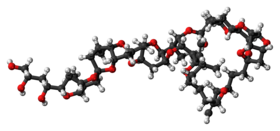Chemistry:Halichondrin B

| |

| |
| Names | |
|---|---|
| IUPAC name
(1S,2S,2′S,3S,3aS,3a′S,5R,6S,7S,7′S,7aS,7a′S,9S,12S,14R,16R,18S,20S,22R,26R,28S,29S,30R,34R,37S,39R,40S,41R,43R,44S)-7,7′,14′′,29′′-tetramethyl-8′′,15′′-dimethylidene-2-(1,3,4-trihydroxybutyl)decahydro-3′H,32′′H-dispiro[furo[3,2-b]pyran-5,5′-furo[3,2-b]pyran-2′,24′′-[2,19,23,27,31,38,42,45,47,48,49]undecaoxaundecacyclo[32.9.2.1~3,40~.1~3,41~.1~6,9~.1~12,16
~.0~18,30~.0~20,28~.0~22,26~.0~37,44~.0~39,43~]nonatetracontan]-32′′-one
| |
| Identifiers | |
3D model (JSmol)
|
|
| ChEMBL | |
| ChemSpider | |
PubChem CID
|
|
| UNII | |
| |
| |
| Properties | |
| C60H86O19 | |
| Molar mass | 1111.329 g·mol−1 |
Except where otherwise noted, data are given for materials in their standard state (at 25 °C [77 °F], 100 kPa). | |
| Infobox references | |
Halichondrin B is a polyether macrolide originally isolated from the marine sponge Halichondria okadai by Hirata and Uemura in 1986.[1] In the same report, these authors also reported the exquisite anticancer activity of halichondrin B against murine cancer cells both in culture and in in vivo studies. Halichondrin B was highly prioritized for development as a novel anticancer therapeutic by the United States National Cancer Institute[2] and, in 1991, was the original test case for identification of mechanism of action (in this case, tubulin-targeted mitotic inhibitor) by NCI's then-brand-new "60-cell line screen"[3][4] The complete chemical synthesis of halichondrin B was achieved by Yoshito Kishi and colleagues at Harvard University in 1992,[5] an achievement that ultimately enabled the discovery and development of the structurally simplified and pharmaceutically optimized analog eribulin (E7389, ER-086526, NSC-707389).[6][7] Eribulin was approved by the U.S. Food and Drug Administration on November 15, 2010, to treat patients with metastatic breast cancer who have received at least two prior chemotherapy regimens for late-stage disease, including both anthracycline- and taxane-based chemotherapies.[8] Eribulin is marketed by Eisai Co. under the tradename Halaven.
Biosynthesis
While a producer organism for Halichondrin B has never been isolated in pure culture, the structural features of Halichondrin B, such as the 'odd-even' rule of methylation, and the abundance of oxygen heterocycles, suggest it is a product of dinoflagellate polyether metabolism.[9] In support of this conjecture, the known dinoflagellate toxin okadaic acid was isolated from the same species of sponge.[10]
References
- ↑ "Halichondrins - antitumor polyether macrolides from a marine sponge". Pure Appl. Chem. 58 (5): 701–710. 1986. doi:10.1351/pac198658050701.
- ↑ "Success Story: Halichondrin B (NSC 609395) E7389 (NSC 707389)". Developmental Therapeutics Program, National Cancer Institute. http://www.dtp.nci.nih.gov/timeline/noflash/success_stories/S4_halichondrinB.htm.
- ↑ "NCI-60 DTP Human Tumor Cell Line Screen". Developmental Therapeutics Program, National Cancer Institute. http://www.dtp.nci.nih.gov/branches/btb/ivclsp.html.
- ↑ "Halichondrin B and homohalichondrin B, marine natural products binding in the vinca domain of tubulin. Discovery of tubulin-based mechanism of action by analysis of differential cytotoxicity data". J. Biol. Chem. 266 (24): 15882–9. August 1991. doi:10.1016/S0021-9258(18)98491-7. PMID 1874739.
- ↑ "Total synthesis of halichondrin B and norhalichondrin B". J. Am. Chem. Soc. 114 (8): 3162–3164. 1992. doi:10.1021/ja00034a086.
- ↑ "In vitro and in vivo anticancer activities of synthetic macrocyclic ketone analogues of halichondrin B". Cancer Res. 61 (3): 1013–21. February 2001. PMID 11221827.
- ↑ "Discovery of E7389, a fully synthetic macrocyclic ketone analogue of halichondrin B". Anticancer agents from natural products. Washington, DC: Taylor & Francis. 2005. ISBN 978-0-8493-1863-4.
- ↑ "FDA approves new treatment option for late-stage breast cancer" (Press release). USFDA. 2010-11-15. Retrieved November 15, 2010.
- ↑ Van Wagoner, Ryan M.; Satake, Masayuki; Wright, Jeffrey L. C. (2014-06-16). "Polyketide biosynthesis in dinoflagellates: what makes it different?". Natural Product Reports (Royal Society of Chemistry (RSC)) 31 (9): 1101–37. doi:10.1039/c4np00016a. ISSN 0265-0568. PMID 24930430.
- ↑ Tachibana, Kazuo; Scheuer, Paul J.; Tsukitani, Yasumasa; Kikuchi, Hiroyuki; Van Engen, Donna; Clardy, Jon; Gopichand, Yalamanchili; Schmitz, Francis J. (1981). "Okadaic acid, a cytotoxic polyether from two marine sponges of the genus Halichondria". Journal of the American Chemical Society (American Chemical Society (ACS)) 103 (9): 2469–2471. doi:10.1021/ja00399a082. ISSN 0002-7863.
 |

